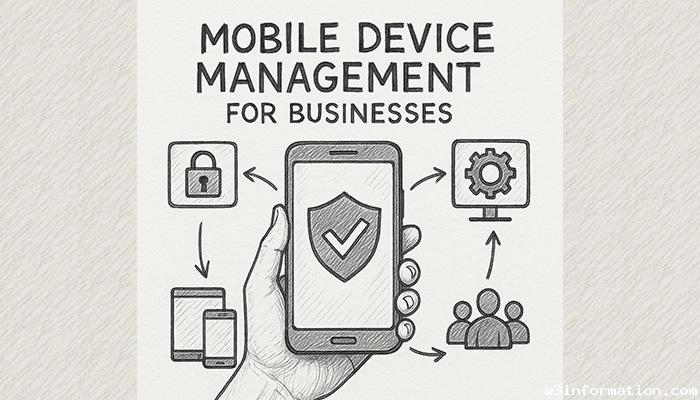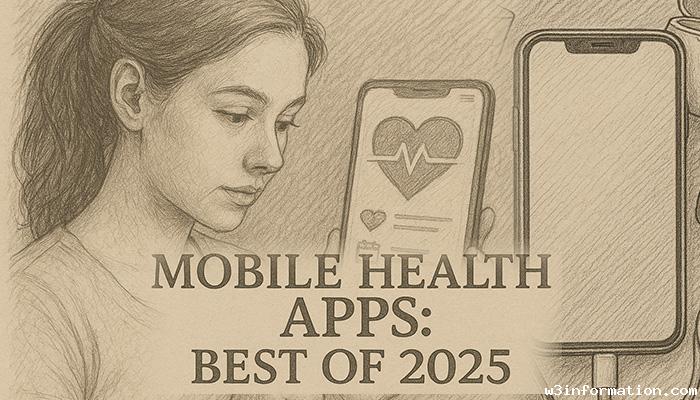Mobile Device Management for Businesses
Businesses today depend increasingly on mobile devices to optimize efficiency and enhance productivity while facilitating better communication. The modern workplace now depends on mobile devices such as smartphones and tablets along with laptops and wearable technology. The widespread use of mobile technology creates a significant need for effective management and security measures for these devices. Mobile Device Management (MDM) solutions become essential in this context. This blog post will examine the MDM concept and its relevance to business operations while highlighting its advantages and the top implementation strategies for organizations.
1. What is Mobile Device Management (MDM)?
Defining MDM
Mobile Device Management (MDM) provides businesses with a complete security system to manage and protect their employees’ mobile devices. MDM gives IT administrators control over mobile devices while enabling them to enforce security policies and safeguard corporate data. MDM ensures network-connected devices follow security protocols while protecting the organization from risks associated with lost or stolen devices and unauthorized access by malware.

Core Functions of MDM:
- Device enrollment and configuration
- Security policy enforcement (e.g., password requirements, encryption)
- The ability to remotely erase data from devices that have been lost or stolen helps maintain corporate data security.
- Monitoring device usage and app installations
- Managing updates and patches
Businesses that permit employees to access company resources through personal or corporate mobile devices need MDM solutions to maintain operational efficiency and security.
2. Why MDM is Crucial for Businesses
Enhanced Security
Data security stands as the most critical issue for businesses regarding mobile devices. Sensitive business information accessed through mobile devices attracts cybercriminals because these devices become their prime targets. MDM solutions mitigate data breach risks by providing device encryption and secure VPNs while enabling remote data wiping to guard against theft and unauthorized access.
- Remote Wipe: MDM enables businesses to perform remote data wipes on lost or stolen devices which protects sensitive information from unauthorized access.
- Device Encryption: MDM solutions protect mobile devices through encryption which prevents unauthorized access to data despite any device compromises.
Compliance and Regulatory Requirements
Businesses are required to protect customer data and maintain secure communication channels through strict compliance regulations set by many industries. Your devices remain compliant with industry standards including GDPR (General Data Protection Regulation) and HIPAA (Health Insurance Portability and Accountability Act) because MDM solutions enforce compliance policies on all mobile devices.
- Policy Enforcement: MDM solutions enforce corporate security policies by requiring employees to use passwords and biometrics while maintaining secure communication methods.
- Audit and Reporting: MDM tools generate detailed reports and device usage logs which businesses use to maintain compliance and conduct necessary audits.
3. Benefits of MDM for Businesses
1. Increased Productivity
MDM enables businesses to boost employee productivity by providing secure access to essential resources no matter if they are working from the office or a remote location. Staff members can effortlessly connect to company networks and use applications while keeping communication active with colleagues and protecting company data.
App Management: MDM solutions allow employees to use only approved applications which prevents the installation of distracting or insecure software.
Remote Support: Remote support from IT teams enables device troubleshooting and app updates along with support services which cuts down downtime and enhances employee satisfaction.
2. Cost Savings
MDM solutions enable businesses to decrease expenditures by minimizing the likelihood of data breaches and securing sensitive information and company devices. MDM implementation reduces manual management and security efforts for mobile devices which results in decreased operational expenses.
Reduced Downtime: Remote device management enables employees to minimize time spent on device problems while allowing IT staff to resolve issues more rapidly.
Reduced Risk of Data Breaches: Through proactive security measures like device encryption and secure remote wiping organizations can lessen breach chances and avoid substantial data breach expenses.
3. Better Device Control
MDM provides businesses total supervision over every mobile device that connects to the company network. IT administrators hold the capability to adjust settings while installing required software and keeping all devices current with recent security patches and software updates.
App Whitelisting/Blacklisting: MDM systems enable businesses to manage device app installations by blocking unauthorized applications that present security threats or break company rules.
Device Configuration: Through remote access administrators have the ability to adjust devices by setting up Wi-Fi, VPN access, email parameters and other business-oriented applications.
4. Top Guidelines for Deploying MDM in Your Business
1. Develop a Clear MDM Policy
Businesses need to create a detailed MDM policy that defines mobile device usage rules and security protocols before implementing an MDM solution. This policy should cover:
- Device security measures (passwords, encryption, etc.)
- App usage and data access rules
- Procedures for handling lost or stolen devices
- Employee privacy considerations
A clear MDM policy helps employees understand mobile security significance and follow organizational guidelines.
2. Choose the Right MDM Solution
Multiple MDM solutions exist so organizations must select the one that best matches their requirements. Look for a solution that offers:
- Scalability: Your business must be able to expand its device management as it incorporates more devices.
- User-Friendliness: IT teams can manage devices easily through this intuitive user interface.
- Integration: The capability to work alongside other enterprise systems including mobile applications VPNs and business email platforms needs to be present.
- Cross-Platform Support: The solution supports a wide range of operating systems across different devices, including iOS, Android, and Windows.
Microsoft Intune, VMware Workspace ONE, MobileIron, and Jamf represent leading MDM solutions in the market.
3. Employee Education and Training
MDM solutions can enforce security policies on mobile devices but employee education remains an important aspect. Train your employees on secure device usage by covering:
- Users must understand steps to generate secure passwords alongside methods for activating biometric authentication features.
- Recognizing phishing attempts and other mobile threats.
- Reporting lost or stolen devices immediately.
One of the strongest methods to prevent security breaches is to maintain a workforce that has received proper education.
5. Future Trends in MDM
Mobile Device Management will undergo changes to handle fresh challenges and opportunities as mobile device usage grows.
- AI Integration: MDM will heavily incorporate artificial intelligence (AI) to automate threat detection while monitoring devices and ensuring compliance enforcement.
- Remote Work Support: MDM solutions must evolve to control devices operating in both office settings and remote work environments as these work models gain popularity.
- Zero Trust Security: Upcoming MDM solutions are expected to combine with zero-trust security frameworks to guarantee that corporate resources remain accessible solely to authenticated users and devices.
Conclusion
Businesses require Mobile Device Management systems for device security enhancement and operational streamlining while boosting productivity. The growing trend of remote work combined with the expanded use of mobile devices has made Mobile Device Management essential like never before. When businesses adopt an effective MDM strategy alongside strong policy development and employee education they can secure their sensitive data while boosting operational efficiency and reducing mobile device risks.
The evolution of mobile technology will lead to advanced MDM solutions which will provide stronger security and management options for contemporary workplaces.
 DIY Holiday Decor Ideas on a Budget
DIY Holiday Decor Ideas on a Budget
 How to Create a Healthy Meal Plan for the Week
How to Create a Healthy Meal Plan for the Week
 Discover your top 10 comforting meals to enjoy during the winter season
Discover your top 10 comforting meals to enjoy during the winter season
 Tips for Stress-Free Holiday Travel
Tips for Stress-Free Holiday Travel
 Mobile Video Editing Apps to Try
Mobile Video Editing Apps to Try
 Mobile Health Apps: Best of 2025
Mobile Health Apps: Best of 2025